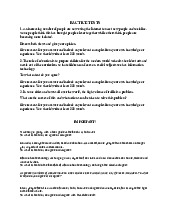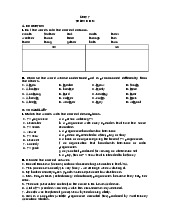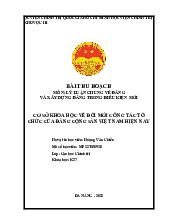







Preview text:
lOMoAR cPSD| 40190299
Mla format exercises - writing c1 practice
Academic Writing C1 (Đại học Khoa học Xã hội và Nhân văn, Đại học Quốc gia Thành phố Hồ Chí Minh) lOMoAR cPSD| 40190299
Name_______________________________________________________Date_____________________
ENG 102: COMPOSITION II
INSTRUCTOR: Y. BAILEY-KIRBY
THE MLA FORMAT EXERCISE PACKET:
(IN-TEXT CITATIONS, WORKS CITED, PARAPHRASING, SUMMARIZING,
QUOTING, AND USE OF BRACKETS, SLASHES, & ELLIPSIS)
PART I: IN-TEXT CITATIONS EXERCISE
Directions: You will need to use a separate sheet of paper when you Include a parenthetical in-text citations at the end of each quote,
paraphrase, or summarized passage below.
1. Provide a parenthetical citation at the end of the quoted material below from page 6 in this anonymous source: “The Impact of
Global Warming in North America.” GLOBAL WARMING: Early Signs. 1999. Web. 23 Mar. 2009.
We see so many global warming hotspots in North America likely because this region has “more readily
accessible climatic data and more comprehensive programs to monitor and study environmental change.”
2. Provide the first author's last name (that’s listed first in this source) followed by et al. or list all the last names in a
parenthetical citation at the end of the quoted material below from page 25 in the following source: Stein, Norman, Mindy
Lubber, Stuart L. Koman, and Kathy Kelly. Family Therapy: A Systems Approach. Boston: Allyn, 1990. Print.
“Help your step children find their own identity in their own space. You can do this by allowing them to decorate
their space the way they want. Even better, you can make it a project for the both of you.”
3. Provide a parenthetical citation for a block quote with two authors from page 189 in the following source: Nazarene, Jacob and
Sarah Moses. Marriage Rules. Chicago: Tyndale, 2011. Print.
The rules of a successful marriage are clearly outlined for newlyweds and seasoned couples in Marriage Rules:
First, you must marry the right person, one you love and one who loves you. Second, give and take is a
necessity. Let love cover the disagreements which will come in any marriage. Three, never carry into tomorrow
the petty troubles of today. Forgive at the end of the day, and then forget. Four, don't discuss your
disagreements and personal problems with others. You will soon forget these quarrels, but others will
remember them forever. Five, try to live within your financial means. Don't try to keep up with some other
couple; keep within your income. And be sure to set aside something for a rainy day.
4. Provide parenthetical citations to distinguish two separate quoted sources by the same author for the first passage on page 47 in the
following source: Kurtz, Michelle. Insiders and Outsiders. New York: Random House, 2005. Print. As for the second quote, the
passage comes from page 92 by the same author, but the second source is as follows: Kurtz, Michelle. American Debutante. New
York: Simon & Schuster, 2008. Print.
Some personal revelations about self-awareness come from the same woman who originally wrote:
“The outsider reigns terror on the common man’s ignorance until they reach enlightenment and can reach out to the outside
with courage and faith,” but in later years, she also reveals her growth and development: “It was not very long
before I was taught proper etiquette and all the social graces to
be ready for my first high society Ball.”
5. Provide a parenthetical citation for a source with one author from page 3 in the following source: Burke, Kenneth. Language as
Symbolic Action: Essays on Life, Literature, and Method. Berkeley: U of California P, 1966. Print.
A. Human beings have been described by Kenneth Burke as "symbol-using animals."
B. Human beings have been described as "symbol-using animals." lOMoAR cPSD| 40190299
PART II: WORKS CITED EXERCISE
Directions: On a separate sheet of paper, you will apply the MLA format for the “Works Cited” page for the following sources.
1. For the following online source, you will need to list it in the correct order for the MLA format.
Author: Wolfgang Jung and Nathan Nelson Page Range: 642-44
Essay/Article Title; “Nature’s Rotary Electromotors” Title of Website, Project, or Online Book: Science Online Journal Title: Science Medium of Publication: Web
Date of Publication: April 29, 2005 Date Accessed: March 5, 2009
2. For the following book by one author, you will need to list it in the correct order for the MLA format. Author: Patricia Henley Publisher: MacMurray
Book Title: The Hummingbird House Date of Publication: 1999 City of Publication: Denver Medium of Publication: Print
3. For the following example of a work in an anthology, you will need to list it in the correct order for the MLA format. Author: Robert Burns Publisher: Dover
Poem Title: “Red, Red Rose” Date of Publication: 1995
Title of Anthology: 100 Best-Loved Poems Page Range:26 Editor: Philip Smith Medium of Publication: Print City of Publication: New York
4. For an anonymous article in a periodical, you will need to list it in the correct order for the MLA format.
Title of Article/Essay: “Aging; Women Expect to Care for Aging Parents but Seldom Prepare.”
Title of Periodical: Women’s Health Weekly Page Range: 18
Date of Publication: May 10, 2007 Medium of Publication: Print .
5. For a source with more than three authors, you will need to list it in the correct order for the MLA format. You may choose to list
only the first author followed by the phrase et al. (Latin for “and others”) in place of the subsequent authors’ names,
or you may list all the authors in the order in which their names appear on the title page. (Note that there is a period after
“al” in “et al.” Also, there is never a period after the “et” in “et al.”)
Authors: Anne Frances Wysocki, Johndan Johnson-Eilola, Cynthia L. Selfe, and Geoffrey Sirc Publisher: Utah State UP
Book Title: Writing New Media: Theory and Applications for Expanding the Teaching of Date of Publication: 2004 Composition
City and State of Publication: Logan, UT Medium of Publication: Print
PART III: QUOTING EXERCISE
Directions: Use a separate sheet of paper and insert double and single quotations marks when needed.
1. In Araby by James Joyce, the boy reveals his epiphany at the end: I saw myself as a creature driven and derided by vanity; and my
eyes burned with anguish and anger (5).
2. According to Sammy in A & P by John Updike, “That's all right,” Lengel said. "But this isn't the beach" when Queenie tells him
that she only came to pick-up a jar of herring snack for her mother (37).
3. Edwin Arlington Robinson demonstrates irony when he writes, And Richard Cory, one calm summer night, / Went home and put
a bullet in his head (15-16). lOMoAR cPSD| 40190299
PART IV: SUMMARIZING EXERCISE
In summarizing texts, you will want to gather the main points by condensing the information to ¼ the original text. Consider the following steps to help you:
• Skim the text to get a general idea of the topic.
• Delete unnecessary or redundant material
• Find the main ideas (Who, What, Where, When, Why, How?) in the text
• Find or create a topic sentence (for each paragraph or section).
• Substitute general or "umbrella" terms when appropriate (for example, trees instead of oak, maple, and pine).
Directions: Use a separate sheet of paper and summarize the following text in example one and two below. EXAMPLE ONE:
STEP ONE: Read the poem and underline key words while omitting unnecessary details.
“Eldorado” by Edgar Allen Poe
STEP TWO: In your own words, write one sentence for each stanza that gathers a main point being presented
on the what, who, where, when, why and how of this poem? Gaily bedight, A gallant knight,
Stanza 1:______________________________________________________________________________ In sunshine and in shadow, Had journeyed long, Singing a song,
Stanza 2:______________________________________________________________________________ In search of Eldorado.
Stanza 3:______________________________________________________________________________ But he grew old - This knight so bold -
Stanza 4:______________________________________________________________________________ And o'er his heart a shadow Fell as he found No spot of ground
STEP THREE: In one or two sentences, summarize this poem in your own words by reviewing your main points That looked like Eldorado. above. And, as his strength Failed him at length,
_________________________________________________________________________________________ He met a pilgrim shadow - "Shadow," said he,
_________________________________________________________________________________________ "Where can it be - This land of Eldorado?"
_________________________________________________________________________________________ "Over the mountains Of the Moon,
Note: Eldorado (or El Dorado) is Spanish for “the gilded one.” Spanish explorers coined the term in the early 1500's to refer to a legendary South American
Down the Val ey of the Shadow,
tribal chief in northern South America. According to tales the Spaniards heard, this ruler presided over a kingdom rich in gold and precious gems. It was
said that he covered his body with gold dust during festivals, then later washed it of in a lake. The “golden city” in which he was believed to reside was Ride, boldly ride,"
called Omagua (or Omoa). As time passed, the kingdom itself came to be called Eldorado, and explorers from Spain, Portugal, Germany, and England The shade replied -
searched northern reaches of the continent to find the kingdom and its fabulous treasures. None of the expeditions succeeded. Subsequently, Eldorado "If you seek for Eldorado!"
was used to refer to any place or any enterprise promising to yield wealth or opportunity. EXAMPLE TWO:
Abraham Lincoln wrote this letter to Mrs. Bixby during the Civil War, and it was featured in the World War II movie Saving Private Ryan. November 21, 1864 Dear Madam,
I have been shown in the files of the War Department a statement of the Adjutant General of Massachusetts that you are the mother of five sons who have
died gloriously on the field of battle.
I feel how weak and fruitless must be any word of mine which should attempt to beguile you from the grief of a loss so overwhelming. But I cannot
refrain from tendering you the consolation that may be found in the thanks of the Republic they died to save.
I pray that our Heavenly Father may assuage the anguish of your bereavement, and leave you only the cherished memory of the loved and lost, and the lOMoAR cPSD| 40190299
solemn pride that must be yours to have laid so costly a sacrifice upon the altar of freedom.
Yours, very sincerely and respectfully, Abraham Lincoln
STEP ONE: Read the letter and underline key words while omitting unnecessary details. Use a dictionary if you do not understand a term.
STEP TWO: In your own words, write one sentence for each stanza that gathers a main point being presented on the what, who,
where, when, why and how of this poem?
Paragraph 1:______________________________________________________________________________
Paragraph 2:______________________________________________________________________________
Paragraph 3:______________________________________________________________________________
STEP THREE: In one or two sentences, summarize this poem in your own words by reviewing your main points above.
__________________________________________________________________________________________________________________
__________________________________________________________________________________________________________________
__________________________________________________________________________________________________________________
PART V: PARAPHRASING EXERCISE
Directions: On a separate piece of paper, write a paraphrase of each of the following passages. Try not to look back at the original passage
and remember to cite the source in the MLA format for each one.
1. "The Antarctic is the vast source of cold on our planet, just as the sun is the source of our heat, and it exerts tremendous control on our
climate," [Jacques] Cousteau told the camera. "The cold ocean water around Antarctica flows north to mix with warmer water from the
tropics, and its upwellings help to cool both the surface water and our atmosphere. Yet the fragility of this regulating system is now
threatened by human activity." From "Captain Cousteau," Audubon (May 1990):17.
2. "The twenties were the years when drinking was against the law, and the law was a bad joke because everyone knew of a local bar where
liquor could be had. They were the years when organized crime ruled the cities, and the police seemed powerless to do anything against it.
Classical music was forgotten while jazz spread throughout the land, and men like Bix Beiderbecke, Louis Armstrong, and Count Basie became
the heroes of the young. The flapper was born in the twenties, and with her bobbed hair and short skirts, she symbolized, perhaps more than
anyone or anything else, America's break with the past." From Kathleen Yancey, English 102 Supplemental Guide (1989): 25.
3. "Of the more than 1000 bicycling deaths each year, three-fourths are caused by head injuries. Half of those killed are school-age children.
One study concluded that wearing a bike helmet can reduce the risk of head injury by 85 percent. In an accident, a bike helmet absorbs the
shock and cushions the head." From "Bike Helmets: Unused Lifesavers," Consumer Reports (May 1990): 348.
4. "Matisse is the best painter ever at putting the viewer at the scene. He's the most realistic of all modern artists, if you admit the feel of the
breeze as necessary to a landscape and the smell of oranges as essential to a still life. "The Casbah Gate" depicts the well-known gateway Bab
el Aassa, which pierces the southern wall of the city near the sultan's palace. With scrubby coats of ivory, aqua, blue, and rose delicately
fenced by the liveliest gray outline in art history, Matisse gets the essence of a Tangier afternoon, including the subtle presence of the
bowaab, the sentry who sits and surveys those who pass through the gate." From Peter Plagens, "Bright Lights." Newsweek (26 March 1990): 50.
5. "While the Sears Tower is arguably the greatest achievement in skyscraper engineering so far, it's unlikely that architects and engineers have
abandoned the quest for the world's tallest building. The question is: Just how high can a building go? Structural engineer William LeMessurier
has designed a skyscraper nearly one-half mile high, twice as tall as the Sears Tower. And architect Robert Sobel claims that lOMoAR cPSD| 40190299
existing technology could produce a 500-story building." From Ron Bachman, "Reaching for the Sky." Dial (May 1990): 15.
PART VI: BRACKETS EXERCISE
Brackets are used for a number of purposes:
• Use #1: Sometimes, you may wish to clarify or add to an original quote. Put words that are being added to an original quote within brackets. Example A: Original:
She said, “I found their services invaluable.”
Amended: She said, “I found their [printing] services invaluable.” Example B: Original:
According to Katherine Payne, “Many are below our range of hearing, in what is known as infrasound.”
Amended: According to Katherine Payne, “[Elephant rumbles] are below our range of hearing, in what
is known as infrasound.”
***Always put the changes in brackets, not parentheses. This tells your readers exactly how you have altered the original.***
• Use #2: Use brackets as parentheses within parentheses. You will see this with bibliographic references.
Example: (For more on the topic, see The Blue Book of Grammar and Punctuation [2008].)
• Use #3: Use brackets to show the pronunciation of a word.
Example: He mispronounced mischievous [mis-chuh-vuhs].
• Use #4: Use brackets surrounding sic and italicize it. Example:
She wrote, “They made there [sic] beds.”
***The Latin term sic is used to indicate that something written is intentionally left in the original form, which may be incorrect.***
Directions: Place brackets where needed.
1. (For more details on brackets, see The Chicago Manual of Style 2003.)
2. He has difficulty correctly pronouncing nuclear noo-klee-er.
3. The instructions read, “Be sure to tighten it’s sic lid securely.”
4. She said, “My proposal was approved by the committee.” (Note: Clarify the project with marketing inserted in brackets.)
5. Civil War Historian Jacob Maxwell writes, “He issued the Emancipation Proclamation in 1863 and promoted the passage of the
Thirteenth Amendment to the United States Constitution, abolishing slavery, and as the Sixteenth President of the United
States, his most famous speech was the Gettysburg Address.” (Note: Clarify He at the beginning of the quote with
Abraham Lincoln inserted in brackets.)
PART VII: SLASH EXERCISE
The Slash, Slant, Solidus, or Virgule [ / ] (Take your pick of names) is used in several ways, but four main ones are listed below as the most commonly used.
• Use #1: To indicate a choice between words it separates.
Example: Using the pass/fail option backfired on her; she could’ve gotten an A.
• Use #2: The slash can be translated as or and should not be used where the word or could not be used in its place.
Example: To avoid gender problems with pronouns, some writers use he/she, his/her, and him/her. lOMoAR cPSD| 40190299
***Many authorities despise that construction above and urge writers either to pluralize when possible and appropriate (to they, their,
them) or to use he or she, etc. instead. Notice there is no space between the slash and the letters on either side of it.***
• Use #3: There is, however, a space when the slash is used to indicate a line-break in quoted poetry:
Example: Frost wrote, "The woods are lovely, dark, and deep / But I have promises to keep" (13- 14).
***(This way of quoting poetry is limited to four or five lines of verse, within the normal flow of text.)***
• Use #4: When using slashes in a Uniform Resource Locator (URL) for a World Wide Web address
(http://www.ccc.commnet.edu/grammar/) , be especially sure not to include spaces and not to confuse
the slash with its backward cousin, \, used as a path separator in Windows (for example, c:\program files\Adobe).
Directions: Place the slash between the lines of poetry. 1.
“Let the learned say what they can, Tis ready money makes the man.” These lines of poetry by the Englishman William Somerville
(1645-1742) may apply to a current American economic problem.
2. The “hermit” of Robert Bly’s poems of the same name “is a man whose body is perfectly whole. He stands, the storm behind him,
And the grass blades are leaping in the wind. Darkness is gathered in folds. About his feet. He is no one.”
3. W.B. Yeats wrote, “When you are old and grey and full of sleep And nodding by the fire, take down this book And slowly read of
the soft look Your eyes had once, and of their shadows deep.”
PART VIII: ELLPSIS EXERCISE
Sometimes it is necessary to omit context from quoted material. An ellipsis ( . . . ) is used to indicate something was omitted. MLA requires
ellipsis before or after the words used when you are quoting more than just a word or a phrase; however, writers only need to use ellipsis if
it’s unclear that the quotation does not completely reproduce the original passage.
For example, a writer would not need to use ellipsis in the following sentence: Lincoln spoke of “government of the people, by the people, for the
people” in the Gettysburg Address. In this case, it’s clear that the writer is not quoting the entire speech or even an entire sentence. Importantly,
MLA advises writers to ensure that omission does not change the meaning of the quoted material (the author’s intent) or create grammatical errors.
Ellipsis in MLA Within a Sentence:
To form an ellipsis in MLA within a sentence, use three periods with a space before each period and a space after the last period. Notice
that the punctuation before and after an omission is included in MLA (the introductory phrase in the example below is maintained in the
version where parts are omitted).
• Original: Dampened by years of self-distrust, displaced by years of corporate codependency in which we have channeled our
creative energies into managing others’ perceptions of us, those energies awaken with startling power and poignancy.
• Parts Omitted: “Dampened by years of self-distrust, . . . those energies awaken with startling power and poignancy” (Bryan, Cameron, and Allen 188).
Ellipsis at the End of a Sentence:
To form an ellipsis in MLA when the omitted material appears at the end of your sentence, type the ellipsis with three periods with space
before each period and include the closing quotation marks immediately after the third period. Note that the period to end your sentence
comes after the parenthetical citation.
• Original: It also requires you to listen to emotions, not just to facts, and to understand the players – speaker and audience
– intended and otherwise.
• Parts Omitted: Bryan, Cameron, and Allen emphasize that listening “. . . requires you to listen to emotions . . .” (147).
If your sentence ends in omitted material and a parenthetical citation isn’t used, then four periods are included in the ellipsis, with no
space before the first period or after the last one. lOMoAR cPSD| 40190299
Ex. Winston Churchill in a speech that became known as We Shall Fight on the Beaches declared, “We shall go on to the end,
we shall fight in France . . . we shall fight on the beaches, we shall fight on the landing grounds, we shall fight in the fields and in
the streets, we shall fight in the hills; we shall never surrender. . . ."
Ellipsis Within a Paragraph:
When quoting paragraphs in MLA style, you may need to omit entire sentences. If the omission begins at the end of a sentence, simply
include the ellipsis in addition to the closing punctuation of the previous sentence:
• Original: On a side note, why do airports have to be so challenging to navigate? Terminals and gates and going up to go down.
Sound-minded individuals become utterly lost. Anxious and jet-lagged individuals have no hope. I mean, you can hire people to
navigate the process of buying a plane ticket, but why can't you hire someone to navigate the airport? Better yet, we should just have airport safaris.
• Parts Omitted: “On a side note, why do airports have to be so challenging to navigate? . . . Sound-minded individuals become
utterly lost. Anxious and jet-lagged individuals have no hope” (Jones 1).
If the omission begins in the middle of a sentence, include the ellipsis and the punctuation of that sentence only if it is needed for
the resulting quotation to make sense:
• Original: On a side note, why do airports have to be so challenging to navigate? Terminals and gates and going up to go down.
Sound-minded individuals become utterly lost. Anxious and jet-lagged individuals have no hope. I mean, you can hire people to
navigate the process of buying a plane ticket, but why can't you hire someone to navigate the airport? Better yet, we should just have airport safaris.
• Parts Omitted: “On a side note, . . . you can hire people to navigate the process of buying a plane ticket, but why can't you
hire someone to navigate the airport?” (Jones 1)
[The comma from the first sentence is included since it is needed grammatically to maintain the introductory phrase on a side note.]
• Original: The French teacher taught me the most--he gave an update on the situation in the North. Though peace has come, the
war left its toll. He said that students aren't learning in school because they did not receive basic training from their parents--there
was no time or thought for training while they were being killed or avoiding being abducted.
• Parts Omitted: “The French teacher taught me the most[:] . . . He said that students aren't learning in school because they did
not receive basic training from their parents” (Jones 1).
[The colon is added in brackets to indicate an addition was made to the original in order to make the whole sentence grammatically
correct. Without it, the sentence would be a run-on. The dash could also be retained.] Ellipsis in Poetry:
For poetry, MLA includes a line of ellipses, approximately the length of a complete line of the poem if an entire line is omitted from a poem.
• Parts Omitted from Poem:
In his poem Marginalia, Collins paints a picture of those delightful side comments that so many writers use:
Sometimes the notes are ferocious, skirmishes against the author
raging along the borders of every page in tiny black script.
Sometimes the notes are ferocious, .............................
raging along the borders of every page
in tiny black script. (1, 3-4)
Ellipses in Work that Includes Ellipsis:
If the original work includes ellipses, include your ellipses in brackets [. . .] to distinguish between yours and the author’s. lOMoAR cPSD| 40190299
• Original: I had an experience I can't prove, I can't even explain it, but everything . . .tells me that it was real. I was part of something
wonderful, something that changed me forever; a vision of the Universe that tells us undeniably how tiny, and insignificant, and how rare and precious we all are.
• Parts Omitted: “I had an experience I can't prove, I can't even explain it, but everything . . . tells me that it was real. I was part of
something wonderful, [. . .] a vision of the Universe that tells us undeniably how tiny, and insignificant, and how rare and precious
we all are” (Contact 231).
Directions: For each of the following, use an ellipsis to replace the underlined material.
1. You not only must understand your audience but also keep this audience in mind at all times as you draft your paper. Many times your
audience will be dictated to you by your instructor or workplace situation; other times you will get to choose an audience. In either case,
you’ll have to understand and then adapt your writing to that audience
- From the second page of Summer Leibensperger’s “Define the Purpose, Consider the Audience, and Develop
the Thesis” copyrighted 2003.
2. Of key importance to the theoretical structure of the model is the tenet that individual styles must be assessed and that, if a learner is
going to have the best opportunity to learn, instructional techniques must be used that are congruent with each student’s style.
-From page 205 in DeBello’s “Comparison of Eleven Major Learning Styles Models” copyrighted 1990.
3. The thought police would get him just the same. He had committed--would have committed, even if he had never set pen to paper--the
essential crime that contained all others in itself. Thought-crime, they called it.
-From page 19 in Orwell’s book 1984.
4. I wish I could explain this place to you . . . everywhere is green and in the near distance a great mountain juts out against the sky, beckoning.
- From page 3 Karalyn Jones’ blog, copyrighted 2008





